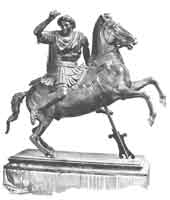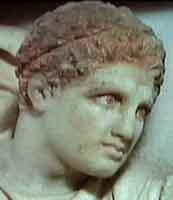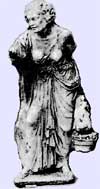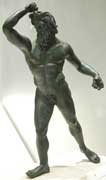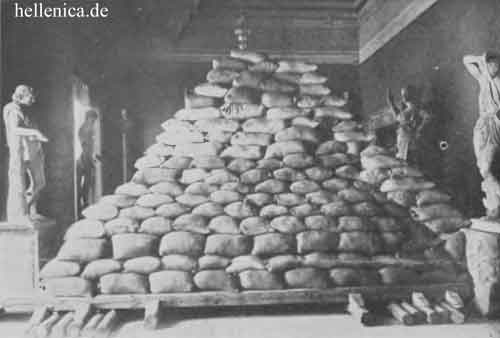.
Parts : 1 - 2 - 3 - 4 - 5 - 6 - 7 - 8 -
A provocative idea is that all the Greek or Roman sculptures are not pieces of art, because the ancient Greek “artists” were only craftsmen and not “intellectuals” like today artists who do art for art (if there is someone who really believes this). There is the idea that “Arts” as we understand it today is something developed in the 18th century, and the “artists” before were actually artisans.
The description of works of art became a highly developed literary exercise, and the results are often as formulaic as the epigrams about Myron’s cow. Those that give the best idea of the way in which, in the real world, cultivated people looked at works of art is the collection known simply as Pictures by the orator Philostratus. These little essays purport to record extemporaneous speeches made by the author in front of the paintings in his patron’s collection for the edification of the patron’s ten-year-old son. One of the most extensive and remarkable concerns a picture of a boar hunt. In addition to the descriptive naturalism, Philostratus admires the arrangement of episodes: the skill with which the story is told. He is especially responsive to the characterization of the hunters: “one shows in his face a touch of the palaestra, another shows grace, another urbanity, and the fourth, you will say, has just raised his head from a book.” He also notes the conceptual complexity of the picture: the four hunters are led by a fifth, a boy of great beauty, with whom they are obviously all in love, so that the pursuit of the boar is paralleled by their pursuit of him. Surprised by the intensity of his absorption, Philostratus exclaims: How I have been deceived! I was deluded by the painting into thinking that the figures were not painted but were real beings, moving and loving – at any rate I shout at them as if they could hear and I imagine that I hear some response – and you did not utter a single word to me to turn me back from my mistake, being as much overcome as I was . . .Antiquity and the Middle Ages, Chapter 1
How Did the Greeks Look at Greek Art?
Plato considered artists less important than any worker since they produce immitations of immitations "a mimesis of a mimesis". Maybe Art is useless because you do not need the instances (paintings, sculptures) to understand the beautiful if you are a philosopher, you can directly apprehend the beautiful itself.
 |

A curiosity of nature the Venus Medici Carrot (a Venus punica), 1912 |
Did the display of the nude Aphrodite of Cnidos produce a chaos as the “artistic” event ”VB55” of Vanessa Beecroft in Berlin? At least many ancient Greek tourists visited the Aphrodite Temple with the sculpture inside. Unfortunately the original Aphrodite of Cnidos was lost and we have only some copies from the Romans.
Aphrodite of Cnidus, Eros, Aphrodite of Rhodes, Praxiteles and the Hetaera Phryne , From Courtesans to Cleopatra: The Portrayal of Women in Hellenistic Art and Literature

The divine madness of the orgiastic Maenad
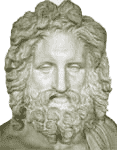
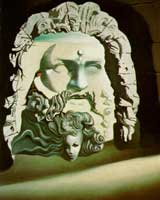
Zeus of Otricoli and Destino (Salvador Dali 1946)
Zeus of Otricoli, late Hellenistic copy of a work of Bryaxis (330 BC) (Austrian website)
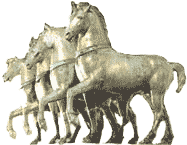
The horses (Quadriga) of Lysippus , (are the horses Greek or Roman and how were they produced?) experts have problems to confirm if this work is a work of Lysippus (some evidence that it is: The ears of the horses are like that of Bucephalas, the horse of Alexander the Great)
Hellenistic Art - Hellenistische Kunst
Hellenistic Art (often despised by the academical world) was not anymore so conservative as the classical Greek Art. The Art is characterized by its dynamic character ( Athlete, runner) even in the case of the sleeping Satyr.
There is an attention on a specific moment, a greater almost perfect realism and we have also complex interacting group of sculptures (symplegmata).
Nymph Escaping from a Satyr
The Townley Group "symplegma", what is not shown is the state of the Satyr, which can be seen better from the top of the sculpture.

The narcistic Aphrodite Kallipygos observes her rear side mirrored from the water on the bottom.
..., for there are figures which are of a moral character, but only to a slight extent, and all do not participate in the feeling about them. Again, figures and colors are not imitations, but signs, of moral habits, indications which the body gives of states of feeling. The connection of them with morals is slight, but in so far as there is any, young men should be taught to look, not at the works of Pauson, but at those of Polygnotus, or any other painter or sculptor who expresses moral ideas. Aristotle Politics
Aphrodite with the nice buttocks and molecular biology


Is the Apollo Belvedere too perfect? Nietzsche was critical with Apollo because he required a balance between the Spirit of Apollo and Dionysos. Did Picasso not say that perfection is the death of Art?
Apollo Belvedere, the anatomy of a god (the beauty of Apollo and at the end a link with information about the beauty of Jesus Christ)
Diana of Versailles and another copy the Artemis in Antalya
Artemis of Cos
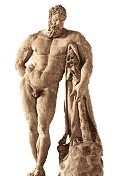
Wolfgang von Goethe visited Rome in 1787. After seeing the Hercules Farnese he said that it is one of the most perfect works of Arts.
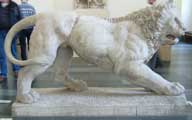
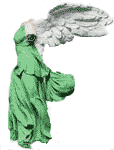
The Nike of Samothrace landing on a war-ship
Probably a symbol of the victory at Side of the Rhodians against the naval force of Antiochus III the Great commanded by Hannibal

In a hand (lost) Aphrodite of Melos (Venus de Milo) holds proud the apple of Paris given to the kallistiti, the most beautiful woman. Although this sculpture if probably the most famous Hellenistic sculpture no text from antiquity survived mentions this work.

Venus de Milo: What was she doing with her arms?
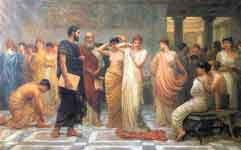
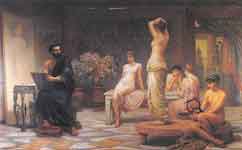
Zeuxis chooses five models from Croton for his Helen of Troy
In a modern study many images of faces of different women were combined to form an average face. The result was a face of a beautiful woman. The DNA combinatorics tells us that the number of possible women is limited although much much larger than the current female world population. Using Weber-Fechner's logarithmic law we can estimate how much more our senses will react viewing the "absolute perfect Aphrodite" in comparison to Venus de Milo A similiar procedure was used by the Greek painter Zeuxis to produce his painting of Helena. Dionysius of Halicarnassus reports that the Crotonians admired Zeuxis so much that when he asked they did send to him their daughters nude to study their anatomy. He selected five girls from which he finally produced an ideal image of Helena which made him rich. You had to pay Zeuxis to see his nude Helena. For this reason the drawing was called the Helena Hetaira. The modern Greek painter Tsarouhis once said that not only in principle no ancient Greek painting survived but that we also have lost the ability to understand ancient Greek Art. The ancient historian Aelianus said that one visitor in Athens observed how much excited the Greek painter Nicomachus was having seen for the first time the Helena of Zeuxis. He asked Nicomachus: What is what you admire so much? Nicomachus reply: You would not ask if you had my eyes!
Aphrodite of Melos (Venus de Milo)

Attalus II, sculpture of Niceratus the son of Euctemon (according to Bernard Andreae)


Apollo Sauroktonos, the Lizard-Slayer
Demosthenes Statue from Polyeuktos of Athens, c. 280 BC. Roman copy of the bronze original, Ny Carlsberg Glyptothek Copenhagen.

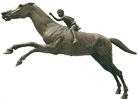

Grave relief. Pentelic marble. Ethiopian groom attempts to restrain a horse

Nice and good the sculptures of heroes and gods but did the Greeks not produce sculptures of children? I found a interesting sculpture of a young Greek child . I tried to find some information about this sculpture until accidentally after months I found a Greek book for children (The “cold statue”) dedicated entirely to this sculpture which I learned was discovered in 1922 in Smyrna. It was just before the so called Asia Minor catastrophe where all Greeks had to leave this place (including my grandmother) where they lived for more than 2500 years and which is now part of Turkey. The sculpture is now called the “little refugee”. Accidentally also I found a picture of a Greek boy from the great Greek photographer Dimitris Tloupas. The young boy and his clothes looked so similar with that of the ancient sculpture even after 2300 years.
The boy with the goose is probably the young Antiochus V, the son of Antiochus IV Epiphanes. Boethus of Chalcedon produced a sculpture of Antiochus IV and probably he represented also his son
Ancient Greek Children: A Boy with a Goose, a Boy with a Duck and the refugee from Minor Asia



|
Hermaphroditus: "Away from me cold-blooded woman Unearthly calm descended from the sky |
| Ancient Greece
Science, Technology , Medicine , Warfare, , Biographies , Life , Cities/Places/Maps , Arts , Literature , Philosophy ,Olympics, Mythology , History , Images Medieval Greece / Byzantine Empire Science, Technology, Arts, , Warfare , Literature, Biographies, Icons, History Modern Greece Cities, Islands, Regions, Fauna/Flora ,Biographies , History , Warfare, Science/Technology, Literature, Music , Arts , Film/Actors , Sport , Fashion --- |

